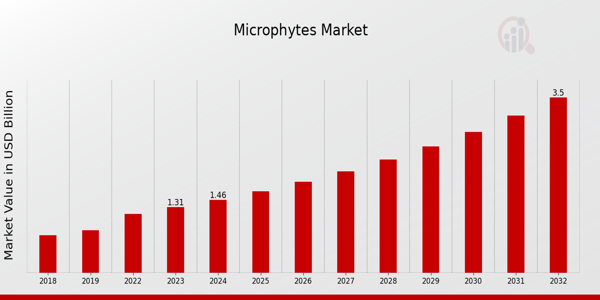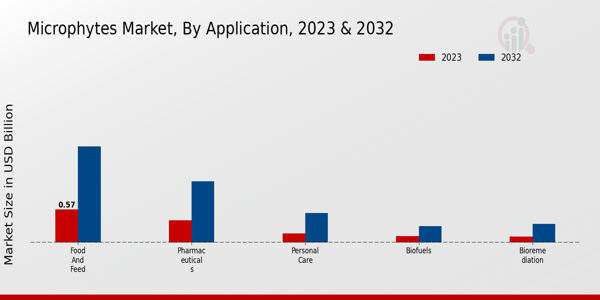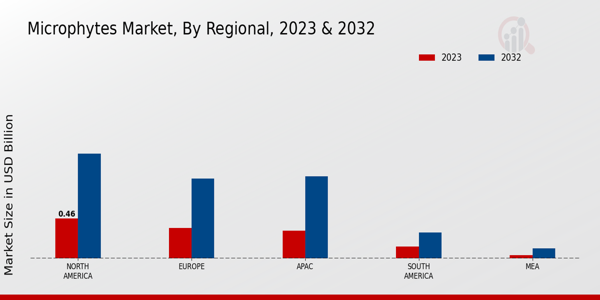Global Microphytes Market Overview
The Microphytes Market Size was estimated at 1.64 (USD Billion) in 2024. The Microphytes Market is expected to grow from 1.83 (USD Billion) in 2025 to 4.87 (USD Billion) by 2034. The Microphytes Market CAGR (growth rate) is expected to be around 11.5% during the forecast period (2025 - 2034).
Key Microphytes Market Trends Highlighted
The Microphytes Market is witnessing substantial growth, primarily fueled by the increasing demand for natural and sustainable food sources. Microphytes are recognized for their nutritional advantages and are commonly utilized in dietary supplements.
Heightened awareness regarding the health benefits of microalgae, including omega-3 fatty acids and antioxidants, is driving consumer interest. Furthermore, the rapid expansion of the aquaculture industry is generating significant demand for microphyte applications as feed and nutrient sources in fish farming.
The growth of the pharmaceutical and cosmetics industries is also playing a pivotal role in market expansion, as microphytes are increasingly incorporated into health products and beauty formulations. Numerous opportunities within this market remain to be explored or fully realized.
The growing interest in plant-based diets and vegan products presents an opportunity for microphytes to be marketed as a source of alternative proteins. Research investments into enhancing the cultivation processes of microphytes can lead to higher yields and improved product quality, making them more attractive to consumers and businesses.
Moreover, partnerships between research institutions and industries can foster innovation and unlock new applications of microphytes ranging from biofuels to biopolymers, thus diversifying the market landscape.
In recent times, there has been a noticeable trend towards sustainability and environmental consciousness, which aligns well with the characteristics of macrophytes. As more companies commit to eco-friendly practices, the adoption of microphytes in various industries is likely to grow.
The rise of biotechnology applications involving microphytes highlights their potential beyond traditional uses, pushing boundaries into areas such as bioremediation and carbon capture.
This trend reflects a broader movement towards integrating sustainable practices across multiple sectors, paving the way for further innovation in the use of microphytes in markets.

Source: Primary Research, Secondary Research, MRFR Database and Analyst Review
Microphytes Market Drivers
Growing Demand for Sustainable and Natural Products
The Microphytes Market is experiencing a notable surge in demand for sustainable and natural products, particularly as consumers become more health-conscious and environmentally aware.
The shift towards eco-friendly solutions is prompting various industries, including food and beverage, cosmetics, and pharmaceuticals, to explore the incorporation of microphytes as a key ingredient.
Microphytes, including various types of algae and phytoplankton, are valued for their unique nutritional properties and health benefits.
For instance, they are rich in proteins, vitamins, minerals, and antioxidant compounds, making them ideal for health supplements and food additives.
Additionally, the production of microphytes is viewed as more sustainable compared to traditional agriculture, as they require less land and water and can be cultivated in controlled environments.
Consequently, as the focus on sustainable and natural product sourcing intensifies, the Microphytes Market is likely to witness accelerated growth.
This trend is further supported by increased research and development in microphyte extraction and processing technologies, enhancing the accessibility and functionality of these products.
Industries are actively seeking alternatives to synthetic ingredients, and microphytes offer an organic solution that aligns with the principles of clean-label products.
With the expected growth in market valuation, manufacturers and suppliers of microphytes are positioned to capitalize on this demand and innovate products that cater to a more conscious consumer base.
Rise in Health and Wellness Awareness
The rise in health and wellness awareness ly is a significant driver for the Microphytes Market. With more consumers prioritizing their health, there is increasing interest in dietary supplements that include natural ingredients.
Microphytes are recognized for their health benefits, making them ideal components for supplements that promote overall wellness. This trend is reshaping the market as brands seek to incorporate more natural sources into their products, further driving the demand for microphytes.
Technological Advancements in Cultivation and Harvesting
Technological advancements in the cultivation and harvesting of microphytes are propelling the Microphytes Market forward. Innovations in aquaculture and bioreactor systems are improving efficiency, allowing for higher yields and cleaner production processes.
As technology continues to evolve, it enhances the scalability of microphyte cultivation. This is crucial for meeting the increasing consumer demands and opens up new opportunities for diverse applications across various sectors, thereby supporting substantial market growth.
Microphytes Market Segment Insights
Microphytes Market Application Insights
The Application segment of the Microphytes Market encompasses various sectors, including Food and Feed, Pharmaceuticals, Personal Care, Biofuels, and Bioremediation, reflecting a diverse set of uses that contribute to the market's growth trajectory.
In 2023, the Food and Feed sector held a significant share, with a market valuation of 0.57 USD Billion, which is projected to expand to 1.65 USD Billion by 2032, showcasing its dominance and importance as a vital source of nutrition and sustainable feeding solutions for both humans and livestock. This segment is driven by the increasing demand for natural and health-oriented food products, making it a crucial player in the overall market.
The Pharmaceuticals sector, valued at 0.38 USD Billion in 2023, is anticipated to grow to 1.05 USD Billion by 2032, highlighting the expanding role of microphytes in drug development and healthcare, particularly for their bioactive compounds and therapeutic potentials. This growth is supported by rising healthcare needs and a growing inclination towards natural remedies.
The Personal Care segment, although smaller, with a valuation of 0.15 USD Billion in 2023, is expected to reach 0.50 USD Billion by 2032. This indicated a growing recognition of the benefits of microphytes in cosmetic formulations and personal care products, driven by the increasing consumer preference for natural ingredients that promote skin health and beauty.
On the other hand, the Biofuels segment, valued at 0.11 USD Billion in 2023, is projected to grow to 0.28 USD Billion in 2032. The renewable energy drive emphasized this segment's potential, as microphytes can contribute significantly to sustainable biofuel production, aligning with energy transition goals.
Lastly, the Bioremediation sector, with a valuation of 0.10 USD Billion in 2023, is also expected to see growth, reaching 0.32 USD Billion by 2032. This sector illustrated the potential of microphytes in environmental cleanup and pollution mitigation efforts, thereby contributing to ecological sustainability.
Overall, the Application segment of the Microphytes Market was characterized by significant growth opportunities driven by innovation, sustainability trends, and the increasing adoption of microphytes across various industries, making it a key area of interest for stakeholders and investors alike as the market continues to evolve.
The diversification of applications in this segment underlines the importance of Microphytes Market revenue growth, showcasing its resilience and adaptability in response to changing consumer preferences and market demands, making it an appealing area of investment within the broader market context.

Source: Primary Research, Secondary Research, MRFR Database and Analyst Review
Microphytes Market Product Type Insights
The Microphytes Market encompasses diverse product types, predominantly including Algae, Cyanobacteria, Diatoms, and Dinoflagellates. Each of these categories plays a crucial role in the ecosystem and various industries.
Algae are widely recognized for their applications in food, cosmetics, and biofuels, significantly contributing to market growth. Cyanobacteria, often noted for their environmental benefits, foster sustainable practices by improving soil quality and aiding water purification processes.
Diatoms stand out due to their unique silica cell structures, which have made them favorable in marine industry applications and filtration systems. Dinoflagellates are known for their bioluminescent properties and are significant in aquatic ecosystems, thus enjoying recognition in research and education.
The Microphytes Market segmentation reflects growth driven by awareness of health benefits and their sustainable potential alongside challenges like ecological impact and regulation adherence.
These dynamics shape the landscape of Microphytes Market statistics and data, presenting opportunities for innovation and expansion across various sectors.
Microphytes Market Form Insights
The Microphytes Market, with various forms such as Dry, Liquid, Powder, and Granular, plays crucial roles in the market dynamics. These forms cater to different consumer preferences and applications, making them essential in various industries, including food, pharmaceuticals, and cosmetics.
Liquid forms, for example, have garnered attention for their ease of use, particularly in dietary supplements and beverages, while Dry forms are favored for their longer shelf life and portability.
Powdered microphytes also dominate in the nutrition and health sectors due to their versatility in formulations. The Granular form, while less common, is gaining traction in industrial applications due to its convenient handling and storage characteristics.
The Microphytes Market statistics reveal robust growth drivers such as the rising demand for natural and organic products, alongside increasing consumer awareness regarding health benefits associated with microphytes. However, challenges such as quality control and variations in sourcing may affect the market growth.
Overall, the diversified segmentation of the Microphytes Market underscores the potential for innovation and expansion across various forms, greatly enriching product offerings.
Microphytes Market End Use Insights
The market segmentation comprises diverse applications, including Industrial, Commercial, and Residential uses, which are all integral in driving market growth. The Industrial sector dominates this landscape, driven by its extensive application in biotechnology, pharmaceuticals, and food production, tapping into essential nutrients and bioactive compounds.
Meanwhile, the Commercial segment shows remarkable potential due to increasing consumer demand for sustainable products and practices, making it a significant contributor to the overall market dynamics.
The Residential sector is also gaining traction, fueled by rising consumer awareness of the health benefits of microphytes and their incorporation in home gardening and personal nutrition.
Microphytes Market Regional Insights
The Microphytes Market revenue showcases significant regional variations, with North America leading with a valuation of 0.46 USD Billion in 2023, projected to grow to 1.21 USD Billion by 2032, reflecting its majority holding in the market. Europe followed with a valuation of 0.35 USD Billion in 2023, expected to reach 0.92 USD Billion by 2032, indicating a strong interest in sustainable agricultural practices.
The APAC region also demonstrated notable growth potential, initially valued at 0.32 USD Billion in 2023 and anticipated to increase to 0.95 USD Billion by 2032, driven by rising population demands for food.
In South America, the market was valued at 0.14 USD Billion in 2023 and projected to grow to 0.3 USD Billion by 2032, showing a growing awareness of the benefits of microphytes in agriculture. Meanwhile, the MEA region, while trailing with a valuation of 0.04 USD Billion in 2023, is set to reach 0.12 USD Billion by 2032, presenting opportunities for expansion as awareness builds around environmental sustainability.
Each region contributed uniquely to the overall Microphytes Market statistics, shaped by local agricultural needs and innovations.

Source: Primary Research, Secondary Research, MRFR Database and Analyst Review
Microphytes Market Key Players and Competitive Insights
The Microphytes Market has gained traction in recent years due to the increasing focus on sustainable alternatives in various industries, including food, agriculture, cosmetics, and biofuels. As the demand for high-value products derived from microphytes, such as algae and other microalgae, continues to rise, competition among major players intensifies.
This competitive landscape is characterized by technological innovations, strategic partnerships, and a growing emphasis on research and development to enhance product offerings. The need for sustainable production methods and the potential applications of microphytes in addressing challenges, such as climate change and food security, further drive competition.
Companies operating in this market must navigate regulatory frameworks and consumer preferences while ensuring the scalability and cost-effectiveness of their solutions to maintain a competitive edge.
Ginkgo BioWorks stands as a prominent player in the Microphytes Market, known for its innovative approach to synthetic biology and biotechnology.
The company has successfully established its market presence through a strong focus on research and development, enabling it to develop novel strains of microphytes that demonstrate enhanced productivity and specific traits for various applications.
Ginkgo BioWorks has cultivated partnerships with academic institutions and industry leaders, allowing it to leverage cutting-edge science and technology in the cultivation and utility of macrophytes.
This collaborative approach has significantly strengthened its position within the market, as it seeks to deliver value-added bioproducts derived from microphytes while addressing environmental concerns and ensuring sustainable practices.
Algix plays a vital role in the Microphytes Market by focusing on the cultivation and processing of microalgae to create sustainable materials and products. The company's expertise lies in the utilization of microphytes for a diverse range of applications, including biodegradable plastics and dietary supplements.
Algix's commitment to environmental sustainability and innovation has positioned it as a leader in the circular economy sector, where it seeks to reduce reliance on fossil fuels and promote renewable resources. By emphasizing research and development, Algix continues to push the boundaries of microphyte applications, contributing significantly to the growth of the market.
The company's efforts in enhancing the commercial viability of microphytes and their derived products align with a broader trend towards sustainable solutions, ensuring its competitive presence in this evolving market landscape.
Key Companies in the Microphytes Market Include
- Ginkgo BioWorks
- Algix
- Corbion
- Heliae Development
- Valensa International
- Cellana
- Ocean Nutrition Canada
- Phytonext
- Cargill
- Inventure Foods
- Dunaliella Salina
- AquaBioTech Group
- Cyanotech Corporation
- Algaetech International
Microphytes Market Developments
Recent developments in the Microphytes Market have shown increased activity, particularly as companies like Ginkgo BioWorks and Corbion focus on advancing their biotechnological capabilities. Algix continues to expand its range of microphyte-derived products, aiming to leverage the demand for sustainable solutions.
Heliae Development has been pursuing partnerships aimed at enhancing its growth in algae-based nutrition and is seeing increasing interest in its cultivation techniques.
Additionally, Valensa International and Cyanotech Corporation are ramping up efforts to market their spirulina and other microphyte products in the health and wellness sectors, reflecting a growing consumer focus on plant-based ingredients.
Current affairs reveal that significant investments are being funneled into research and development, with Cellana and Ocean Nutrition Canada leading innovation in omega-3 extraction methods.
Furthermore, notables such as Cargill and Inventure Foods are exploring strategic collaborations within the sector to bolster their portfolios of natural ingredients. As for mergers and acquisitions, reports indicate that some firms are actively seeking opportunities to consolidate their market positions, aiming for greater efficiency and a broader range of offerings, though specific deals have not been widely disclosed in recent months.
The overall market valuation reflects a robust growth trajectory fueled by rising demand for health and sustainability.
Microphytes Market Segmentation Insights
Microphytes Market Application Outlook
- Food and Feed
- Pharmaceuticals
- Personal Care
- Biofuels
- Bioremediation
Microphytes Market Product Type Outlook
- Algae
- Cyanobacteria
- Diatoms
- Dinoflagellates
Microphytes Market Form Outlook
- Dry
- Liquid
- Powder
- Granular
Microphytes Market End Use Outlook
- Industrial
- Commercial
- Residential
Microphytes Market Regional Outlook
- North America
- Europe
- South America
- Asia Pacific
- Middle East and Africa
| Report Attribute/Metric |
Details |
| Market Size 2024 |
1.64 (USD Billion) |
| Market Size 2025 |
1.83(USD Billion) |
| Market Size 2034 |
4.87 (USD Billion) |
| Compound Annual Growth Rate (CAGR) |
11.5% (2025 - 2034) |
| Report Coverage |
Revenue Forecast, Competitive Landscape, Growth Factors, and Trends |
| Base Year |
2024 |
| Market Forecast Period |
2025 - 2034 |
| Historical Data |
2020 - 2024 |
| Market Forecast Units |
USD Billion |
| Key Companies Profiled |
Ginkgo BioWorks, Algix, Corbion, Heliae Development, Valensa International, Cellana, Ocean Nutrition Canada, Phytonext, Cargill, Inventure Foods, Dunaliella Salina, AquaBioTech Group, Cyanotech Corporation, Algaetech International |
| Segments Covered |
Application, Product Type, Form, End Use, Regional |
| Key Market Opportunities |
Sustainable food alternatives, Nutraceuticals expansion, Biofuel production potential, Aquaculture feed enhancement, Cosmetic ingredient innovation |
| Key Market Dynamics |
Rising health consciousness, Increased demand for sustainable products, Technological advancements in cultivation, Growing applications in the food industry, Expanding pharmaceutical uses |
| Countries Covered |
North America, Europe, APAC, South America, MEA |
Frequently Asked Questions (FAQ) :
The Microphytes Market is expected to be valued at 4.87 billion USD in 2034.
The expected CAGR for the Microphytes Market from 2025 to 2034 is 11.5%.
The Food and Feed application segment is anticipated to reach 1.65 billion USD by 2032.
The North American Microphytes Market is projected to grow to 1.21 billion USD by 2032.
Significant players in the Microphytes Market include Ginkgo BioWorks, Algix, and Corbion.
The Pharmaceuticals application segment is expected to be valued at 1.05 billion USD in 2032.
The Bioremediation application is anticipated to reach a market size of 0.32 billion USD by 2032.
The South American Microphytes Market is projected to be worth 0.30 billion USD in 2032.
Growth drivers include increasing demand for sustainable products and advances in biotechnology.
The Personal Care segment is expected to reach a value of 0.50 billion USD by 2032.

















